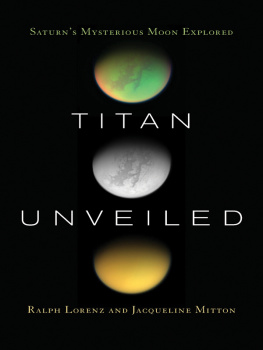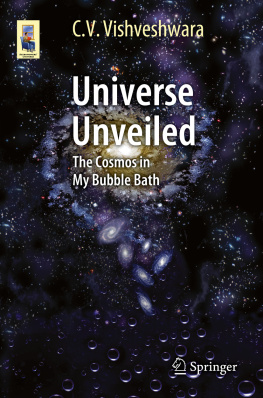Lorenz - Titan Unveiled
Here you can read online Lorenz - Titan Unveiled full text of the book (entire story) in english for free. Download pdf and epub, get meaning, cover and reviews about this ebook. year: 2013, publisher: Princeton University Press, genre: Home and family. Description of the work, (preface) as well as reviews are available. Best literature library LitArk.com created for fans of good reading and offers a wide selection of genres:
Romance novel
Science fiction
Adventure
Detective
Science
History
Home and family
Prose
Art
Politics
Computer
Non-fiction
Religion
Business
Children
Humor
Choose a favorite category and find really read worthwhile books. Enjoy immersion in the world of imagination, feel the emotions of the characters or learn something new for yourself, make an fascinating discovery.
- Book:Titan Unveiled
- Author:
- Publisher:Princeton University Press
- Genre:
- Year:2013
- Rating:3 / 5
- Favourites:Add to favourites
- Your mark:
- 60
- 1
- 2
- 3
- 4
- 5
Titan Unveiled: summary, description and annotation
We offer to read an annotation, description, summary or preface (depends on what the author of the book "Titan Unveiled" wrote himself). If you haven't found the necessary information about the book — write in the comments, we will try to find it.
Lorenz: author's other books
Who wrote Titan Unveiled? Find out the surname, the name of the author of the book and a list of all author's works by series.
Titan Unveiled — read online for free the complete book (whole text) full work
Below is the text of the book, divided by pages. System saving the place of the last page read, allows you to conveniently read the book "Titan Unveiled" online for free, without having to search again every time where you left off. Put a bookmark, and you can go to the page where you finished reading at any time.
Font size:
Interval:
Bookmark:

Titan Unveiled
Titan Unveiled

Titan Unveiled
Titan Unveiled

Saturns Mysterious Moon Explored
With a new afterword by the authors
RALPH LORENZ AND JACQUELINE MITTON
Princeton University Press Princeton and Oxford
Copyright 2008 by Princeton University Press
Published by Princeton University Press, 41 William Street,
Princeton, New Jersey 08540
In the United Kingdom: Princeton University Press, 6 Oxford Street,
Woodstock, Oxfordshire OX20 1TW
press.princeton.edu
All Rights Reserved
Fourth printing, and first paperback printing, with a new afterword, 2010
Paperback ISBN: 978-0-691-14633-1
Cloth ISBN: 978-0-691-12587-9
Library of Congress Control Number: 2007938922
British Library Cataloging-in-Publication Data is available
This book has been composed in Granjon, Berthold Akzidenz Grotesk Condensed
Printed on acid-free paper.
Printed in the United States of America
10 9 8 7 6 5 4
Contents
List of Illustrations and Tables
ILLUSTRATIONS
CHAPTER 1
CHAPTER 2
CHAPTER 3
CHAPTER 4
CHAPTER 5
CHAPTER 6
CHAPTER 7
AFTERWORD
TABLES
Preface
T his book describes the most recent episodes in the unfolding story of the exploration of Saturns largest moon, Titan, arguably a world that offers planetary scientists a richer scientific bounty than any other in the solar system, apart from Earth.
Titan Unveiled is a successor to our earlier book, Lifting Titans Veil (Cambridge University Press, 2002), written before the arrival of the CassiniHuygens mission. However, it is by no means necessary to read Lifting Titans Veil before reading the present book. Each forms a self-consistent account, and emphasizes different aspects of Titan and its exploration.
As in our earlier book, first-person anecdotes have been corralled into short sections headed Ralphs Log (a device suggested by Simon Mitton in 1998 when, it should be noted, blogging was virtually unheard of). These parts are overtly from personal experience but the main narrative is necessarily subjective too.
This is not a deliberate strategy to emphasize the contributions to Titan research of the first author, but rather reflects two factors. Firstly, the surface of Titan and its interaction with the atmosphere have been the most mysterious, and continue to be perhaps the most interesting, aspects of Titan; Lorenz has been intimately involved in two projects hat have so far shed the most light on these aspects: the Huygens probe and the RADAR instrument on the Cassini orbiter. The book, therefore, gives prominence to these investigations. Other Cassini scientists, if writing a similar account, might reasonably highlight other aspects of Titan (and we would encourage them to do so), but we believe that the atmosphere and surface in particular will interest general readers most. Second, as with Lifting Titans Veil, we wanted to illustrate a couple of aspects of planetary science, and indeed, of science in general. Planetary science encompasses a broad range of disciplines, and the complexity of Titan as a planetary object means that studying it embraces a large number of them. This diversity of topics and techniques has been challenging, educational and fun to explore, and we wish to convey some of that excitement and variety. Not all the findings or endeavors we describe represent successes. This too is a feature of science as a process. A theory that best fits the facts of the time is often found wanting as new data emerge, and sometimes an old observation upon which an elegant theory is founded is eventually determined to be false. Thus, science is principally about process, not conclusions; it does not lead unerringly to some ultimate truth, but rather gropes around, making false steps in its search for ever more accurate and succinct descriptions and explanations of the universe around us.
We hope that you, the reader, will enjoy our account and learn from it, and that you will consider some subjective emphasis a reasonable price to pay for our report being from the front line.
Although we name a number of individuals throughout the narrative of our book, the international CassiniHuygens project, and the exploration of Titan as a whole, result from the efforts of literally thousands of people, all of whom can claim credit for their contributions to this great adventure. We are grateful to them all.
RALPH LORENZ
Columbia, MD, USA
JACQUELINE MITTON
Cambridge, UK
Titan Unveiled
Titan Unveiled

Titan Unveiled
1. The Lure of Titan
O n July 1, 2004, the Cassini spacecraft arrived at Saturn after a journey from Earth lasting almost seven years. At 6.8 m in length, this monstrous robotic explorer was the largest western spacecraft ever to be dispatched on an interplanetary mission. Its battery of scientific instruments was designed to return images and data not only from the giant planet itself and its spectacular ring system, but also from members of Saturns family of over fifty moons. Foremost in interest among the diverse collection of icy worlds in orbit around Saturn was Titan, a body so special, so intriguing in its own right that Cassini carried with it a detachable package of instrumentsnamed the Huygens probethat would parachute through Titans atmosphere to observe its surface.
By any reckoning, Titan is an unusual moon. It is 5,150 km acrossnearly 50 percent bigger than our own Moon and 6 percent larger than Mercury. If it happened to orbit around the Sun, its size and character would easily make it as much a planet as Mercury, Venus, Earth, and Mars. But the landscape of this extraordinary world remained hidden to us throughout the first decades of the space age, partially because of Titans remote location and partially because it is swathed in a thick and visually impenetrable blanket of haze. Thanks to CassiniHuygens and the technological advances that have vastly extended the reach of ground-based telescopes, the situation has now changed dramatically. Titan is undergoing an all-out scientific assault both by the most powerful telescopes on Earth and from the cameras and radar aboard Cassini, the flagship international space mission. This observational barrage, topped off by the Huygens probes daring drop down to the surface of Titan, is serving to unveil this enigmatic moon, revealing more of its intriguing features than we have ever seen before.
THE IMPERATIVE TO EXPLORE
When the two Voyager craft sped past Jupiter and Saturn between 1979 and 1981, they returned a wealth of new information about the two giant planets and their moons. But the images and data received from these missions were essentially snapshotsfleeting opportunistic glances at worlds demanding more serious and systematic attention. And as far as Titan was concerned, the results of these flybys were especially disappointing.
Observing Titan was a high priority for the planners of the Voyager missions, and in November 1980, Voyager 1 passed Titan at a distance of 4,394 km. The encounter sent the spacecraft hurtling out of the plane of the solar system and prevented it from exploring any more moons or planets. However, curiosity about Titan was so great that the sacrifice was considered worth making.
Next pageFont size:
Interval:
Bookmark:
Similar books «Titan Unveiled»
Look at similar books to Titan Unveiled. We have selected literature similar in name and meaning in the hope of providing readers with more options to find new, interesting, not yet read works.
Discussion, reviews of the book Titan Unveiled and just readers' own opinions. Leave your comments, write what you think about the work, its meaning or the main characters. Specify what exactly you liked and what you didn't like, and why you think so.















